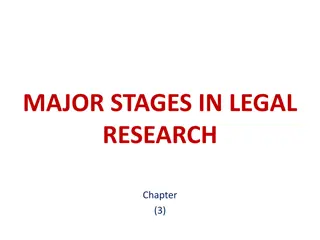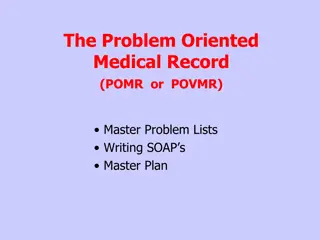Research Methods and Evidence-Based Practice for Problem Identification
This module focuses on problem identification in research and evidence-based practice, emphasizing the importance of identifying the problem before seeking a solution. It covers components of the PICO framework, constructs well-built clinical questions, and provides examples related to hospitalized adolescents with diabetes, aiming to improve outcomes through targeted interventions based on research evidence.
Uploaded on Oct 04, 2024 | 2 Views
Download Presentation

Please find below an Image/Link to download the presentation.
The content on the website is provided AS IS for your information and personal use only. It may not be sold, licensed, or shared on other websites without obtaining consent from the author.If you encounter any issues during the download, it is possible that the publisher has removed the file from their server.
You are allowed to download the files provided on this website for personal or commercial use, subject to the condition that they are used lawfully. All files are the property of their respective owners.
The content on the website is provided AS IS for your information and personal use only. It may not be sold, licensed, or shared on other websites without obtaining consent from the author.
E N D
Presentation Transcript
NRSG 790: Methods for Research and Evidence Based Practice MODULE 5: PROBLEM IDENTIFICATION
Getting Started What is the problem? How do we know it exists? Do we see an outcome deficit, or an area for improvement? Avoid the mistake of identifying a solution first, then go in search of a problem Unclear as to the standard? Is one practice better than another? What does the evidence say? Click to learn more
PICO Components Patient Population Problem Intervention Comparison with other interventions Outcomes that are measurable P I C O T
Hospitalized Adolescents with Diabetes P I C O T
What is Your PICO? Hospitalized adolescents with diabetes P An alternative to print (you specify based on research evidence) I Printed education materials C Reduction of HgA1C to target goal O 6-12 months post program T Students are not permitted to use this PICOT for their paper assignments
Construct Well-Built Clinical Questions Background Questions Ask for general knowledge about a disorder How does the problem occur (what is the cause, incidence, prevalence) What are the effects and complications of the problem (physical, social, psychological, economic, health-care system) How do we generally manage the problem? Foreground Questions Ask for specific knowledge about managing a specific effect of the problem What is the best practice intervention to achieve a desired physical, social, psychological, economic, health-care delivery outcome























